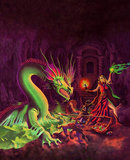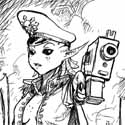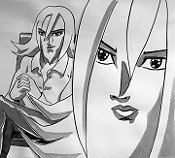|
Night10194 posted:The gridless bit is important. Almost everyone effectively played D&D 3.5 or whatever gridless, and man it was not made for that. Do you have a citation to back that up? Because the vast majority of 3.whatever games I've played in used a grid.
|
|
|
|

|
| # ? Apr 19, 2024 21:11 |
|
senrath posted:Do you have a citation to back that up? Because the vast majority of 3.whatever games I've played in used a grid. Really? I never had a grid in any of the ones I played in.
|
|
|
|
senrath posted:Do you have a citation to back that up? human beings use phrases like "almost everyone" to mean "almost everyone I know".
|
|
|
|
Night10194 posted:Really? I never had a grid in any of the ones I played in. Yeah, the only ones that didn't were either because it was such a small fight that positioning didn't matter, or because we were too drunk to care. Cease to Hope posted:human beings use phrases like "almost everyone" to mean "almost everyone I know". I figured, but I wanted to ask rather than just assume and counter with my own anecdote.
|
|
|
|
lifg posted:On the other hand, everyone describes a successful attack as hitting, and uses words like damage, scratches, and bleeding all the time. Saying, "you feel his ability to dodge a final, fatal blow decreasing," just doesn't have the same panache. As someone who ascribes heavily towards "HP is definitely not meat points, and is more like the ability to avoid a fatal blow, as limited by vitality/endurance/adrenaline/physical energy", I still end up describing hits as bruises, cuts, getting winged, etc., or I just say "they take x damage, ouch" because as you said even if we internally know that it doesn't directly translate into physical harm, the at-the-table narrative demands that we attach some kind of description to it anyway. senrath posted:Do you have a citation to back that up? Because the vast majority of 3.whatever games I've played in used a grid. While I personally share the same experience, it was a common attack line against 4e that "it was the first D&D that strictly required a grid" or something, which leads me to believe either lots of people didn't play 3e with a grid and just houseruled/hand-waved a shitload of interactions with it, or were flat-out lying.
|
|
|
|
They're probably drawing a very fussy line between 5' squares, and arbitrarily large squares.
|
|
|
gradenko_2000 posted:While I personally share the same experience, it was a common attack line against 4e that "it was the first D&D that strictly required a grid" or something, which leads me to believe either lots of people didn't play 3e with a grid and just houseruled/hand-waved a shitload of interactions with it, or were flat-out lying. People did it anyway, but you can hammer nails with a screwdriver if you try hard enough, doesn't mean it's a good idea.
|
|
|
|
|
gradenko_2000 posted:While I personally share the same experience, it was a common attack line against 4e that "it was the first D&D that strictly required a grid" or something, which leads me to believe either lots of people didn't play 3e with a grid and just houseruled/hand-waved a shitload of interactions with it, or were flat-out lying. I don't think I ever ran into that particular argument before. I wonder if anyone ever pointed out to them that the 3.5 rules explicitly reference grids in pretty much every section of the core rules, including their oh-so-precious magic rules.
|
|
|
|
gradenko_2000 posted:
The need for a grid killed 4ed dead for my group. We've always played Gridless and it's never been a problem. Clear description, good will, and hit rolls for fancy aiming of that fireball etc and it's always been fine. We couldn't even play any game with a Grid these days anyway, as our player situation has evolved. We now have a couple of people physically present in the room, and a couple more skyping in on the big screen TV. It sounds odd, but it works suprisingly well. Also for the record I like 5ed and a lot of the changes they made for it from 3.5.
|
|
|
|
I'm trying to say this with zero snark and hostility, but that's what I mean by "people who played 3e without a grid by introducing any number of houserules and handwaving to remove the need for it" ... and then would later go on to say "4e is unplayable for us because it requires a grid, when 3e didn't!" When in reality 3e actually did require a grid, and said so by like page 4 of the PHB, but there's a difference between "our specific group's style of play allows us to ignore the rules that mandate the use of a grid" and "the game natively supports gridless play" (as 13th Age does) EDIT: It's also the case that if you can play 3e gridless with enough houserules and good-faith-actors, then it should technically be possible with 4e as well. You'd be violating or changing some mechanics, to be sure, but if you're attaching a to-hit roll to Fireball to check if it hits friendlies then you were already changing some 3e mechanics too anyway. gradenko_2000 fucked around with this message at 12:17 on Apr 4, 2017 |
|
|
|
senrath posted:Do you have a citation to back that up? Because the vast majority of 3.whatever games I've played in used a grid. Of the eight or more people I know that ran d20 fantasy, I'm the only one I know of that ever used a battle map.
|
|
|
|
I played 3.5 all through college and at no time did we ever use a map or a grid. Now I do remember visiting my friends after college and my friend who was dm'ing busting out a rolled up dry erase square grid map and saying "hey, wouldn't this help?" marshmallow creep fucked around with this message at 12:15 on Apr 4, 2017 |
|
|
|
I always ran 3e with a grid map and so did the D&D group I started withsenrath posted:I don't think I ever ran into that particular argument before. I wonder if anyone ever pointed out to them that the 3.5 rules explicitly reference grids in pretty much every section of the core rules, including their oh-so-precious magic rules. The combat chapter in 3e also demonstrates positioning, attacking, cover, etc. using images of characters on grid layouts. Nuns with Guns fucked around with this message at 12:35 on Apr 4, 2017 |
|
|
|
I mean, yes, obviously 3.5e was designed for a gridmap. When I say 13a genuinely going for gridless combat is one of its pluses, what I mean is that despite 3.5 absolutely kinda needing one in my personal experience my DMs almost never used one. Even our Spycraft X-COM game, which had a huge reliance on cover early on because they had goddamn plasma weapons and I was trying to kill a goddamn Muton with a 23mm soviet anti-jeep shotgun, didn't use a grid. And really should've.
|
|
|
|
First time I ever used a grid for D&D was when I played 4th edition online. Before that I don't think I've ever really had grids, or minis even, in the 3.5 games I've played.
|
|
|
|
Weirdly, when I first played 2e when I was 14, we used a full grid and had a great time picking out and customizing our own lego guys and using specific colored markers for each kind of enemy and building little lego fortresses and battle-scenes. Basically we were using D&D to adjudicate lego fights.
|
|
|
|
3e/3.5 were definitely designed to use a grid, and that's really clear if you look at most of the rules and especially anything it illustrates, particularly movement rules and AOE attack rules. That doesn't mean most groups played it that way, though.
|
|
|
|
Ah, yes, the last survivors of the edition wars. Now gray and pockmarked, meeting at the front lines. Not friends, but with a long-scarred respect for one another.
|
|
|
|
When I learned 3.x in high school, we always used a grid - it's what enabled great shenanigans like our evil Rogue and Monk duo who spent entire combats tumbling into flanking positions, tripping people up, and then curbstomping them down in a single round. I can see how people can get away without using a grid (I've played both gridless and gridded Deathwatch), but it's been my experience that going gridless in D&D enables a lot of fuckery. There are so many rules in 3.x that demand a grid, and you really nerf the hell out of one class (Rogue) without it. Rules like Attack of Opportunity, Flanking, Cover, Line of Sight, etc. I mean, they don't present combat rules like "here's how you play it in TotM:" - they're all presented using the grid, and at least one of the rulebooks comes with a grid in the back for this exact reason. As a result, I was not surprised when I saw the combat rules for 4e and instead the first thought on my mind was "Wow, they really cleaned this up and made it more interesting! Fighters are properly sticky and can actually do poo poo now!" LuiCypher fucked around with this message at 15:29 on Apr 4, 2017 |
|
|
|
I really like how Paranoia handles combat (and basically every roll): The players have a budget of bonus points they can use to add (or subtract, since it's Paranoia) to a roll, and that informs what happens in combat. With this set up, the only positional issue you the player has to worry about is "who's standing behind you?
|
|
|
|
 The Playís the Thing is an interesting rpg. Itís not a superb example of game design, or a massive budget, but it has a fun premise and provides an excellent change of pace to the more serious minded RPGs out there. The basic premise of the game is that the players are all actors in a play. They jockey for parts and will likely (definitely) try to do some improv when theyíre up there. It might be because they forgot their lines, or they didnít pay attention to the script. It might be because they want some more time on stage and are willing to do TERRIBLE things to the plot in order to get their way. So, if youíve ever wanted to be the Tybalt who decides to kill Romeo in the duel, to be the more reasonable MacBeth or to just straight up introduce martial arts to Hamlet, itís up to you. It starts like many other RPG books, a brief history of what inspired the game, a section describing the act of roleplaying. It does have a section which I appreciate which gives a very explicit overview on what the game is about and how to play it. quote:ďIn my game, the players portray actors who have been called by the Playwright to rehearse a Tragedy, comedy, or history. The actors must follow the style, plot, and lines they are given, but will, of course, attempt to improve the play by offering their own suggestions and improvising as often as they can get away with it. The game itself largely follows the structure of a play. The Playwright acts as the director of the play. Each game is divided into Acts. The Players take the role of Actors, are cast in Roles, and will probably (definitely) do what they can to change the play to their liking. In my experience this can range anywhere from adding an extra soliloquy as a scene ends to showing up on stage in cardboard power armor. Itís really going to depend on the group. The Playwright acts as a sort of adjudicator, doing their best to make their dream play a reality despite the continued efforts of all the actors. Story points are the main resource in the game. You get them for following the play as itís currently going, following the themes and plots as theyíve developed, and can spend them to make changes to the play. They are awarded by the Playwright and as a Playwright itís expected youíll be fairly liberal with them. The Actors Most of the players will be Actors. All you need for the actor is a name, a rough idea of what kind of person they are and what they want out of the play. One might want as much stage time and lines as possible. They want to be the center of attention, always. Another might only be here because theyíre bored and are interested in doing the absolute minimum. Another might be the aspiring Oscar winner who treats the play with reverence and acts their heart out in any role. Actors also have Chops which act as their stats and reflect the ways they are best at changing the play. We have Logos: This deals with your ability to change events or the way they unfold. This is changing the results of a duel or an ambush Pathos: This is your ability to affect parts and plots. These rolls let you add plots to characters or ignore others. For example convincing Juliet that Romeo isnít that interesting. Ethos: This is how well you can affect the props and setting of the play. This is how you pull out the hidden stage knife or convince the Playwright the play would be much more interesting on the moon. You have 6 points to allocate to these three stats and none of them can go over 3. It all depends on what youíd like to be best at. You might also notice that these are fairly broad, and might even overlap or require adjudication in certain circumstances. At that point itís best to come to an agreement with the playwright. So, at this point youíre going to pick your actor Type, which acts like your class and represents the kind of person you are on and off the stage. You are given an Onstage Ability which you can use while you are currently in the scene, an Offstage Ability that can be used when you arenít, and a Direction. A Direction is something the Playwright can ask you for that you must do, and can often be a source of additional Story Points. They can, however, only ask once an Act. For example we have: The Ham This is the kind of person who is invigorated by the audience, for good and bad. They live for the applause, the tears, the laughter, all of it. Onstage Ability: They may yell ďCut!Ē, enabling them to suggest a change, without having to spend a story point. Offstage Ability: They may spend a story point to compel an actor on stage to call for you. They can spend their own story point and refuse but if they accept they gain your story point. This is important because under normal circumstances if you are offstage you canít simply walk back on. This allows them to come back on stage at a time of their choosing, even if itís wildly inappropriate for the play. For example if a sinister group is planning the assassination of the actor he can use this ability to hop into the scene which would make things rather awkward but certainly entertaining. Direction: Once an act, when directed by the playwright, you must deliver a soliloquy. It doesnít matter what youíre doing on stage, if youíre the king or the janitor, you have to drop everything to deliver a speech to the audience about what your character is thinking about. Weíll get into these mechanics in more detail further on.  The Basics Once youíve created your actor itís time for Casting. The Playwright will introduce the play, either one already established or one theyíve made themselves. The Playwright should give out a Synopsis of the play as well as a Cast List and give everyone 5 Story Points to start out with. The Playwright will start with a Name for the character, a Part, their Plot and a Prop. Parts are the jobs or titles their character possesses. It represents the basic motivations and duties of the character. Each Part comes with a description of what it entails as well as an Invoke and Compel. An Invoke can be used when you want to change the play in a way that would be in character and gives you bonus dice to the role. A Compel is something the other actors can use to entice you to stay in character through the use of story points. Yes this is similar to FATE. There are several example Parts in the book. The Exile A stranger in strange lands you either cannot return to your home or are forbidden to. Invoke: Gain two dice when acting against those who exiled you Compel: You are alien to this place, act like it. The Knight You follow a lord or ideal with dedication and honor, even against your own interests. Invoke: Gain two dice when fulfilling your commitments Compel: You cannot act against your liegeís will. There are others like Ruler, Commoner and Nurse and are outlined similarly. When making these for a new or existing play theyíre fairly easy to create which is helpful. Plots are similar to Parts but focus instead on how you relate to another character. These can be mutual like between a teacher and student, or entirely one sided. These must relate to other characters in the play and canít be referring to people who are only alluded to. Like Parts these also have Invokes and Compels and can be used to influence the play to your liking and influence you to act more in character. For examples there are Daughter/Son You are the child of another character and, regardless how you feel about them, this is a meaningful bond. Invoke: Gain two dice when dealing with your parents Compel: You must obey the head of the family regardless of how you feel. In Love You are in love with someone to a degree which no one else could fathom. Invoke: Gain two dice when pursuing your love Compel: Love can make us do foolish things Props are items used for dramatic effect on stage and give a die bonus for specific tasks. Unlike Parts and Plots these arenít associated with a specific character. If a knight drops his sword the queen can pick it up and use it herself. Examples: Crown: Add one die when acting as the rightful ruler. Coin: Add one die when convincing someone to follow your plan. Places are specific areas of a Set and act similarly to props though with less rigid guidelines on what situations will give the actor a bonus. For example the Set might be in a castle and through the play itself as well as edits you might add a feasting hall, a throne room, a dungeon and really any place that might conceivably be in a castle. Finally, once youíve been given your roles the Playwright will give you a few Lines that your character will say during the course of the play. These are the well known lines that even people unfamiliar with Shakespeare probably know. "O Romeo, Romeo! Wherefor art thou Romeo?" If you manage to to use one in an appropriate scenario you get a story point. If you do so with gusto, brimming with emotion and chewing the scenery like your life depended on it you might get anywhere between 3 to 5 story points. Knowing what these are we can now talk about players choosing these at the beginning of the play. As written, once the players have their Actors chosen and filled in their Chops the Playwright will introduce the play with a brief summary and provide a complete cast list of all the available parts. The Playwright will then start at the top with the Roleís Name, Plot, Part and associated Prop, as well as a few story points that are awarded to whoever claims it. Players now go around the table and can either Pass on the character, Claim the character and the story points, or Bid on the Character. Bidding on a character is a way of adding to it, making it more complex but potentially more interesting to play. When you Bid on a part you can add an additional Plot or Part and add an additional Story Point to whoever ends up playing it. If there are more parts than there are players the Playwright can read for those parts during play. If a Character goes around twice with no one claiming it it will be read by the Playwright during the game. An Important note. You might end up with a Role which is riddled with Parts, Plots and Props, enough to make actually playing it quite daunting. For better or worse you are limited to the amount of these you can bring on stage and invoke during any given act. You canít have more Parts than your Logos. You canít have more Plots than your Pathos. You canít have more Props than your Ethos. The unused props are going to sit in a trunk offstage. The unused Parts and Plots however can still be invoked by the Playwright and the other actors. The characters themselves donít change based on this either, with the book example being a King still being the King regardless if theyíre using the Ruler Part or not. While they wonít be able to spend a Story Point to gain the extra dice for invoking the Part they can still be targeted by itís Compel. Before the game begins but after Roles have been chosen the actors also have the option of adding their own Parts and Plots to the character under the justification that theyíve seen this story before and already know what theyíre supposed to do. Doing so does require the expenditure of Story Points though.  Coming up: Acting out the Play! e: edited for better formatting unzealous fucked around with this message at 20:20 on Apr 8, 2017 |
|
|
|
Halloween Jack posted:Idunno if you're serious of not, but "HP = Meat Points???" is the silliest D&D argument to have, because Gygax said "Of course not" right in the AD&D1e DMG. Of course I'm not serious. I just fumbled my Sarcasm check. Night10194 posted:Weirdly, when I first played 2e when I was 14, we used a full grid and had a great time picking out and customizing our own lego guys and using specific colored markers for each kind of enemy and building little lego fortresses and battle-scenes. Imagine if WotC was owned by Lego.
|
|
|
|
Huh. I'm reminded of Forsooth! Which is a Shakespearean rpg which comes across closer to Fiasco. Pretty good fun too!
|
|
|
|
Night10194 posted:The gridless bit is important. Almost everyone effectively played D&D 3.5 or whatever gridless, and man it was not made for that. My group started using a grid when Champions came out in the 80s and we continued on using one because it shut down so many arguments regardless of system.
|
|
|
|
 Rifts Index & Adventures Volume 1, Part 3: ďItís a picture of a pleasant looking woman in her forties, wearing a homespun dress and holding a kitten.Ē I mean, Iím not kidding in the review, there is a point where a man tries to guilt the PCs into doing the right thing with picture involving a kitten. Speaking of kittens, I understand they donít ever feel compelled to write reviews of Rifts Index & Adventures Volume 1. That sounds nice. While Iím fantasizing a furrier existence, hereís an adventure where if you scratch out the word ďcyberĒ you can just use it for Dungeons & Dragons. Well, you can use it if your Dungeons & Dragons games take place in Wyoming, anyway. (Well, at least itís not the Forgotten Realms.) Usual caveats involving my bumbling and sound quality apply. Hereís part 3 of the review! This is the reason I will suffer in the next life. The visual guide for part 3 has:  The obviously trustworthy Sir Randall Aswell.  Donít do things like this to innocent artwork, publishers. Next: Mmmetaplot.
|
|
|
|
Giving theatre kids something to play instead of Vampire is an awesome idea.
|
|
|
|
|
Sucks Mark Diaz Truman decided to play tone police through Magpie's own website and at the worst possible moment in ttrpg discourse. Because that game sounds cool, but I would never feel comfortable supporting him again
|
|
|
|
I just played a game of Protocol, and it's a lot like this, conceptually, except with fewer rules and no dice or stats. It's basically just storytelling with some playing cards for randomness and tokens to "break the rules." It was a blast.
|
|
|
|
Evil Mastermind posted:Speaking as someone who started playing back in the day with a Moldivay boxed set from Toy's R Us: the reason we kept playing was because it was just me and my friends who were in my age bracket. I wasn't introduced to the hobby by someone in their late 20's/early 30's who was approaching things in a kill-em-all mindset, we were a bunch of kids in middle school who were doing the best we could with a boxed set that didn't explain things too well and only got you to level 3. Kaza42 posted:I got into D&D from my dad, who was in college when the game first came out. On top of that, I had both the AD&D 2nd edition player's handbook and the AD&D 1st edition player's handbook, and had NO IDEA that they were of different editions, and so used both freely and interchangeably. So for most of my childhood, I played a weird mashup of the rules my dad remembered and played with (which were their own hodgepodge of house rules, misunderstood stuff and basic+ad&d mixed), plus the various Dragon magazine articles, handbooks (I loved the Complete Humanoid book) and the multiple-editions worth of player's handbooks. It wasn't until I played Neverwinter Nights (which was 3e) that I even knew wizards were supposed to have spellbooks they picked spells from, rather than just knowing and using a fixed list. Funny thing is, having this sort of "mashup" experience with D&D is totally normal for anyone who started playing before 3e like I did. D&D is a lot like a religion in this regard: you can claim it's about a central text, but it's just as much about what expectations you bring to it, how you're taught to read and apply the text, how your community of practitioners talks about it, etc. Likewise, your approach to D&D is influenced by what version you have, who teaches it to you, who you play with, what supplements you have, what magazines and newsletters you read, what conventions you go to if any, and if you came to it from a related hobby like wargaming. Especially since OD&D was actually a supplement that was very confusing if you tried to decipher it as a standalone game.
|
|
|
|
Halloween Jack posted:Funny thing is, having this sort of "mashup" experience with D&D is totally normal for anyone who started playing before 3e like I did. Very true. The big problem is that there are people who're trying to retcon that there was always This One Way To Play D&D.
|
|
|
|
There is one true way to play D&D. It's the rulebook of whatever edition you're playing. The issue is the systems have all been busted to the point where that is almost impossible/ unplayable. So you end up with the weird mashups people create. (Except maybe 4th)
|
|
|
|
Count Chocula posted:Whoever's reviewing Dreamhounds of Paris should save that Doom Patrol panel, or just use others from that arc. Duly noted!
|
|
|
|
DNA Cowboys posted:Duly noted! it's vol 2 issue 29
|
|
|
|
The One True Way to play D&D is the Rules Cyclopedia. I mean I'm not even sure why this is being argued, this is pretty much objective truth.  And I recall some people complaining about 3e requiring miniatures, though it wasn't nearly as vocal as people whining about it with 4e. It's doubly funny since a lot of infamous rules like attacks of opportunity are trivial to use on a grid map, but require obnoxious fiating at best in a more freeform style. And it's not like by-the-book D&D rules haven't held close to its wargaming roots forever, to the point that it started out having distances for spells and ranged attacks or whatever listed in inches. You know, as in on your tabletop. Freeform mapless play has always been poorly supported by the rules, which is doubly weird considering it seems to be the way the majority of people play D&D.
|
|
|
|
I suspect a lot of this was ginned up by Paizo in order to support the launch of Pathfinder as a business venture, and to be fair I gather Pathfinder is one of the few RPG product mills/lines/etc. that makes money in a more conventional way rather than by kickstarting all their products and, maybe, having demo games at cons.
|
|
|
|
|
paizo has sold multiple lines of miniatures
|
|
|
|
lifg posted:On one hand, of course not. I once GMed Spycraft for a trial one shot, which has the explicit vitality/wounds split for HP. I managed to confuse all the players by describing enemies dodging after successful hit rolls and had to explain several times that it was due to vitality reduction and how it otherwise wouldn't make sense that a guard could survive 5 bullets. And I find playing without a grid in games that need one just results in trouble as people forget you can't fireball 30 mooks or that there's no room for someone to sneak behind you without getting stabbed on the way.
|
|
|
|
lifg posted:I just played a game of Protocol, and it's a lot like this, conceptually, except with fewer rules and no dice or stats. It's basically just storytelling with some playing cards for randomness and tokens to "break the rules." It was a blast.
|
|
|
|
If I have a copy of the rules of Forsooth! I'll do a write up sometime. I don't recall it being very rules-heavy overall.
|
|
|
|

|
| # ? Apr 19, 2024 21:11 |
|
Asimo posted:The One True Way to play D&D is the Rules Cyclopedia. I mean I'm not even sure why this is being argued, this is pretty much objective truth. I never played BECMI. I started in the mid-70s with white box OD&D, added Greyhawk, Blackmoor, and Eldritch Wizardry along with the Arduin Grimoire. Then AD&D came out and that was when the groups I played with migrated over. When 3.0 came out it took a while to make that change because we were so invested in the previous edition.
|
|
|










































